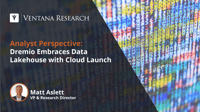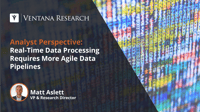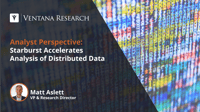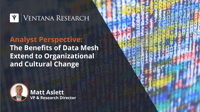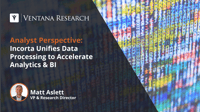When joining Ventana Research, I noted that the need to be more data-driven has become a mantra among large and small organizations alike. Data-driven organizations stand to gain competitive advantage, responding faster to worker and customer demands for more innovative, data-rich applications and personalized experiences. Being data-driven is clearly something to aspire to. However, it is also a somewhat vague concept without clear definition. We know data-driven organizations when we see them...
Read More
Topics:
embedded analytics,
Analytics,
Business Intelligence,
Data Governance,
Data Integration,
Data,
Digital Technology,
natural language processing,
data lakes,
data operations,
Digital Business,
Streaming Analytics,
AI & Machine Learning,
data platforms,
Analytics & Data,
Streaming Data & Events
I previously described the concept of hydroanalytic data platforms, which combine the structured data processing and analytics acceleration capabilities associated with data warehousing with the low-cost and multi-structured data storage advantages of the data lake. One of the key enablers of this approach is interactive SQL query engine functionality, which facilitates the use of existing business intelligence (BI) and data science tools to analyze data in data lakes. Interactive SQL query...
Read More
Topics:
Analytics,
Business Intelligence,
Cloud Computing,
Data,
Digital Technology,
data lakes,
data operations,
AI & Machine Learning,
data platforms,
Analytics & Data
I previously explained how the data lakehouse is one of two primary approaches being adopted to deliver what I have called a hydroanalytic data platform. Hydroanalytics involves the combination of data warehouse and data lake functionality to enable and accelerate analysis of data in cloud storage services. The term data lakehouse has been rapidly adopted by several vendors in recent years to describe an environment in which data warehousing functionality is integrated into the data lake...
Read More
Topics:
business intelligence,
Analytics,
Data,
data lakes,
data platforms
I recently wrote about the importance of data pipelines and the role they play in transporting data between the stages of data processing and analytics. Healthy data pipelines are necessary to ensure data is integrated and processed in the sequence required to generate business intelligence. The concept of the data pipeline is nothing new of course, but it is becoming increasingly important as organizations adapt data management processes to be more data driven.
Read More
Topics:
Analytics,
Business Intelligence,
Data Governance,
Data Integration,
Data,
Digital Technology,
Digital transformation,
data lakes,
data operations,
Digital Business,
AI & Machine Learning,
data platforms,
Analytics & Data,
Streaming Data & Events
I recently described the growing level of interest in data mesh which provides an organizational and cultural approach to data ownership, access and governance that facilitates distributed data processing. As I stated in my Analyst Perspective, data mesh is not a product that can be acquired or even a technical architecture that can be built. Adopting the data mesh approach is dependent on people and process change to overcome traditional reliance on centralized ownership of data and...
Read More
Topics:
Business Continuity,
Analytics,
Business Intelligence,
Data Governance,
Data Integration,
Data,
Digital Technology,
data lakes,
Digital Business,
data platforms,
Analytics & Data
Data mesh is the latest trend to grip the data and analytics sector. The term has been rapidly adopted by numerous vendors — as well as a growing number of organizations —as a means of embracing distributed data processing. Understanding and adopting data mesh remains a challenge, however. Data mesh is not a product that can be acquired, or even a technical architecture that can be built. It is an organizational and cultural approach to data ownership, access and governance. Adopting data mesh...
Read More
Topics:
Analytics,
Business Intelligence,
Data Governance,
Data Integration,
Data,
Digital Technology,
Digital transformation,
data lakes,
data operations,
Digital Business,
data platforms,
Analytics & Data,
Streaming Data & Events
As businesses become more data-driven, they are increasingly dependent on the quality of their data and the reliability of their data pipelines. Making decisions based on data does not guarantee success, especially if the business cannot ensure that the data is accurate and trustworthy. While there is potential value in capturing all data — good or bad — making decisions based on low-quality data may do more harm than good.
Read More
Topics:
Data Governance,
Data Integration,
Data,
Digital Technology,
data lakes,
data operations,
Analytics & Data
I recently described the emergence of hydroanalytic data platforms, outlining how the processes involved in generating energy from a lake or reservoir were analogous to those required to generate intelligence from a data lake. I explained how structured data processing and analytics acceleration capabilities are the equivalent of turbines, generators and transformers in a hydroelectric power station. While these capabilities are more typically associated with data warehousing, they are now...
Read More
Topics:
Analytics,
Data Governance,
Data,
Digital Technology,
data lakes,
data operations,
AI & Machine Learning,
data platforms,
Streaming Data & Events
As I stated when joining Ventana Research, the socioeconomic impacts of the pandemic and its aftereffects have highlighted more than ever the differences between organizations that can turn data into insights and are agile enough to act upon it and those that are incapable of seeing or responding to the need for change. Data-driven organizations stand to gain competitive advantage, responding faster to worker and customer demands for more innovative, data-rich applications and personalized...
Read More
Topics:
Analytics,
Business Intelligence,
Data Integration,
Data,
data lakes,
data operations,
AI & Machine Learning,
data platforms,
Streaming Data & Events
Organizations of all sizes are dealing with exponentially increasing data volume and data sources, which creates challenges such as siloed information, increased technical complexities across various systems and slow reporting of important business metrics. Migrating to the cloud does not solve the problems associated with performing analytics and business intelligence on data stored in disparate systems. Also, the computing power needed to process large volumes of data consists of clusters of...
Read More
Topics:
Analytics,
Business Intelligence,
Data Integration,
Data,
data lakes,
data operations,
Streaming Analytics,
AI & Machine Learning


